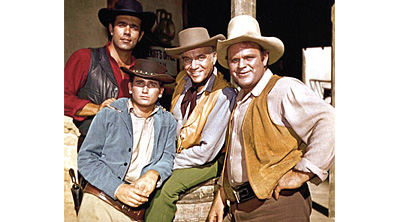Will We Ever See 'Bonanza' in 3D?
HOLLYWOOD—With 3D networks struggling to fill their 24/7 programming schedule with material including multiple repeats of the same sports events in 3D, the need to increase options is becoming urgent.
In his keynote address during the 7th annual Digital TV Summit held in London last month, Tom Cosgrove, president of 3net, the joint venture between Discovery Communications, IMAX and Sony, said that one out of every two new flat panel TV's sold in the United States would be 3D- compatible by 2014. He added the prediction that worldwide sales of 3DTV sets would top 160 million by 2015 which he said was "light years ahead" of HD at this stage of its introduction.

FILLING THE CONTENT BUCKET
But what are we going to watch on those multi-dimensional screens? "When we started 24/7 3D broadcasting one and a half years ago on our 3D channel, n3D, we began with large event productions, which is what we thought audiences would like," said Chris Long, senior vice president of entertainment and production at DirecTV Entertainment who oversees all original content and sports production. "But then we tried to find other original content that had been shot in 3D and found that often the fledgling 3D productions were not up to our standard. So we started filling in with live music events that we could shoot ourselves, and sports events like the 'Bull Riding Championships' we presented in November. We've been aggressive, but original 3D production can be expensive so we've been caught between a rock and a hard place."
But American TV has a huge legacy of popular episodic shows in 2D. So the question arises: Would DirecTV be interested if the programs could be converted to 3D to fill their programming needs?
"The short answer is 'yes,'" Long replied. "But the longer explanation is that the conversion we have seen so far has not been that great unless we spend the enormous amounts of money that feature films can afford. I want our fan viewership to feel they are getting a true 3D experience without getting ripped off."
But DirecTV says that if the 2D-to-3D conversion could pass the Technicolor 3D certification branded "Technicolor Certifi3D" that evaluates each shot against a set of objective criteria for stereographic reproduction, including a 15-point quality checklist, the result could be deemed acceptable.
Does that mean we could potentially see legacy TV episodics like "Bonanza" in 3D? One of the great advantages of classic TV shows is that, unlike the fast-cut style of more recent shows like "CSI" or "Prime Suspect," their relatively leisurely editorial pace lends itself more directly to convincing 2D-to-3D conversion.
"If there were a company that could get the rights to 'Bonanza' and was willing to convert it at a rate I could afford at a quality level that could pass the Technicolor Certifi3D evaluation," Long said, "I would be excited to put 'Bonanza' on our 3D channel."
3D FACTORY
An Australian company called DDD is pursuing just that goal with the introduction of their new "3D Factory" service.
There are three levels of 2D-to-3D conversion according to Chris Yewdall, CEO of DDD: a) the uncompromising high-end exemplified by the mostly manual3D conversion techniques used for feature films at up to $100,000/minute; b) a more cost efficient process that employs automated conversion as a starting point but enhances it with human assistance much like a colorist overseas color grading, and c) the completely automated 2D-to-3D conversion technology that is built into some 3DTVs that extracts 3D depth from a variety of visual cues.
DDD originally developed their TriDef 3D technology to assist 2D-to-3D conversion of scenes in IMAX films in 1997, and modified it to automatically extract 3D images by 2003 for Sharp's Actius RD3D autostereoscopic notebook computer. In March 2008 an evolved version of TriDef 3D was incorporated into Hyundai 3DTV's and by 2010 it was available in all Samsung 3DTVs. By now, over 1 million consumer products using DDD's TriDef 3D technology, including PC's, cellphones and 3DTV sets are shipped monthly.
At the 2010 NAB Show, DDD demonstrated TriDef 3D technology combined with manual, human assistance to create the 3D Factory service for 2D-to-3D conversion.
"The smaller size of a TV screen doesn't require as [much] precise depth information because its resolution is not high as a feature film screen," Yewdall said. "Using the 3D Factory, an operator can decide which algorithm will produce the best depth effect for a given scene, specify how great the 3D effect should be, and determine where the convergence point should be. It is similar to the way an audio engineer would select the proper sound field for a specific type of music, then adjust the sonic equalization and spatial localization to fine tune the result."
The bottom line is that DDD's 3D Factory service when applied to a legacy library of TV shows can convert 500 hours of material in the range of $5 million. That gets the cost down to around $10,000 per hour-long episode, which may bring the conversion of a wealth of legacy TV material into the budget of 3D broadcasters.
"Financially it is viable, technically it is feasible, and certainly the results are palpable," Yewdall said.
"Bonanza" in 3D? It may be coming to a 3DTV screen near you.
The professional video industry's #1 source for news, trends and product and tech information. Sign up below.
